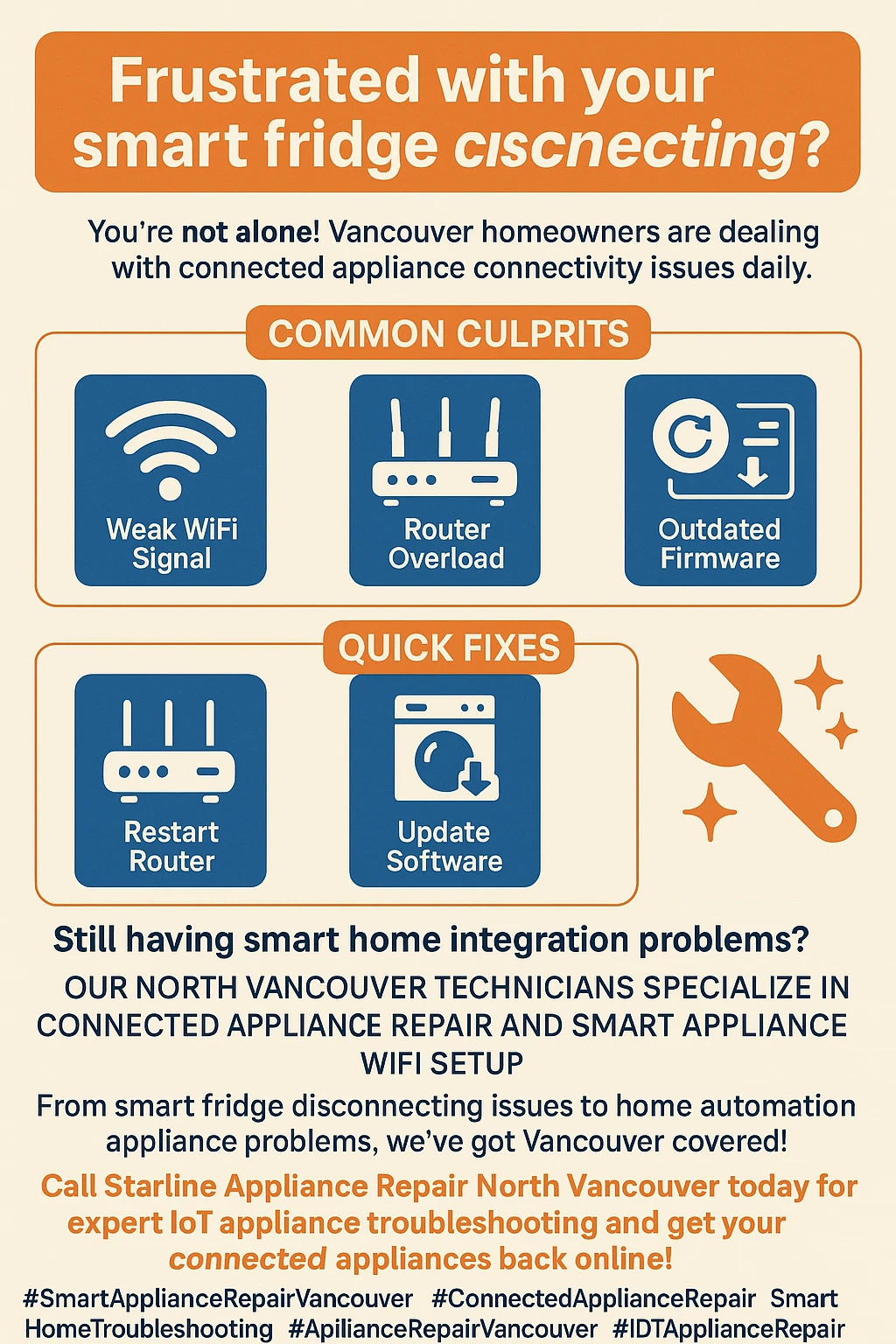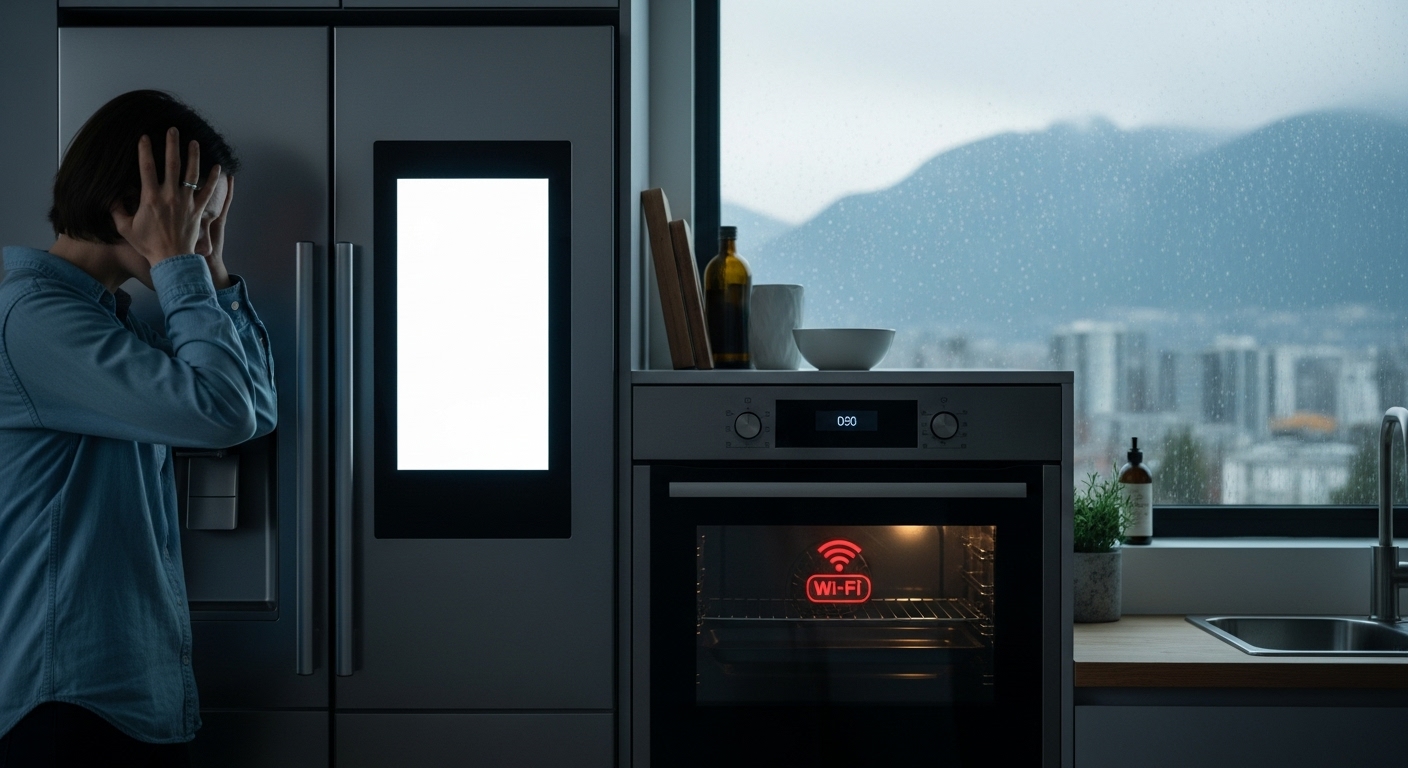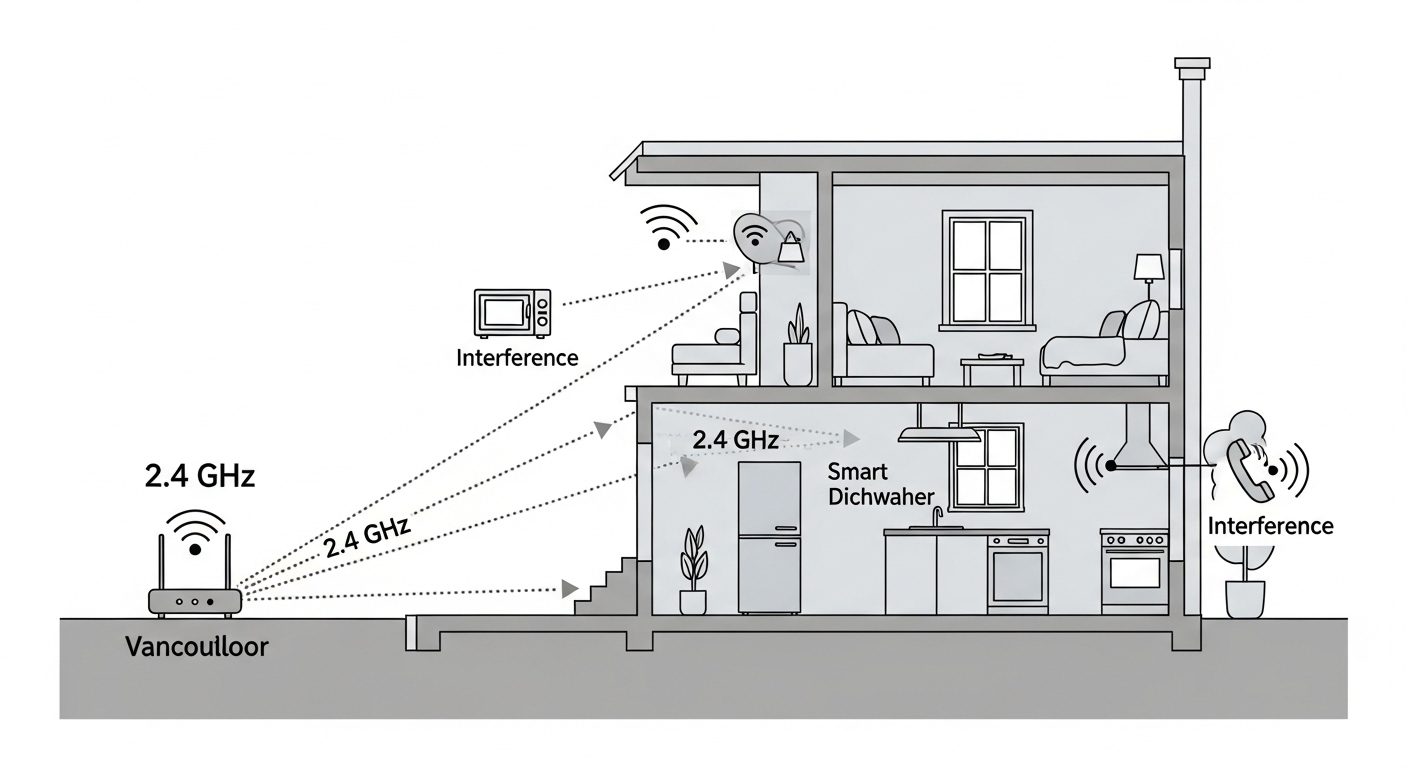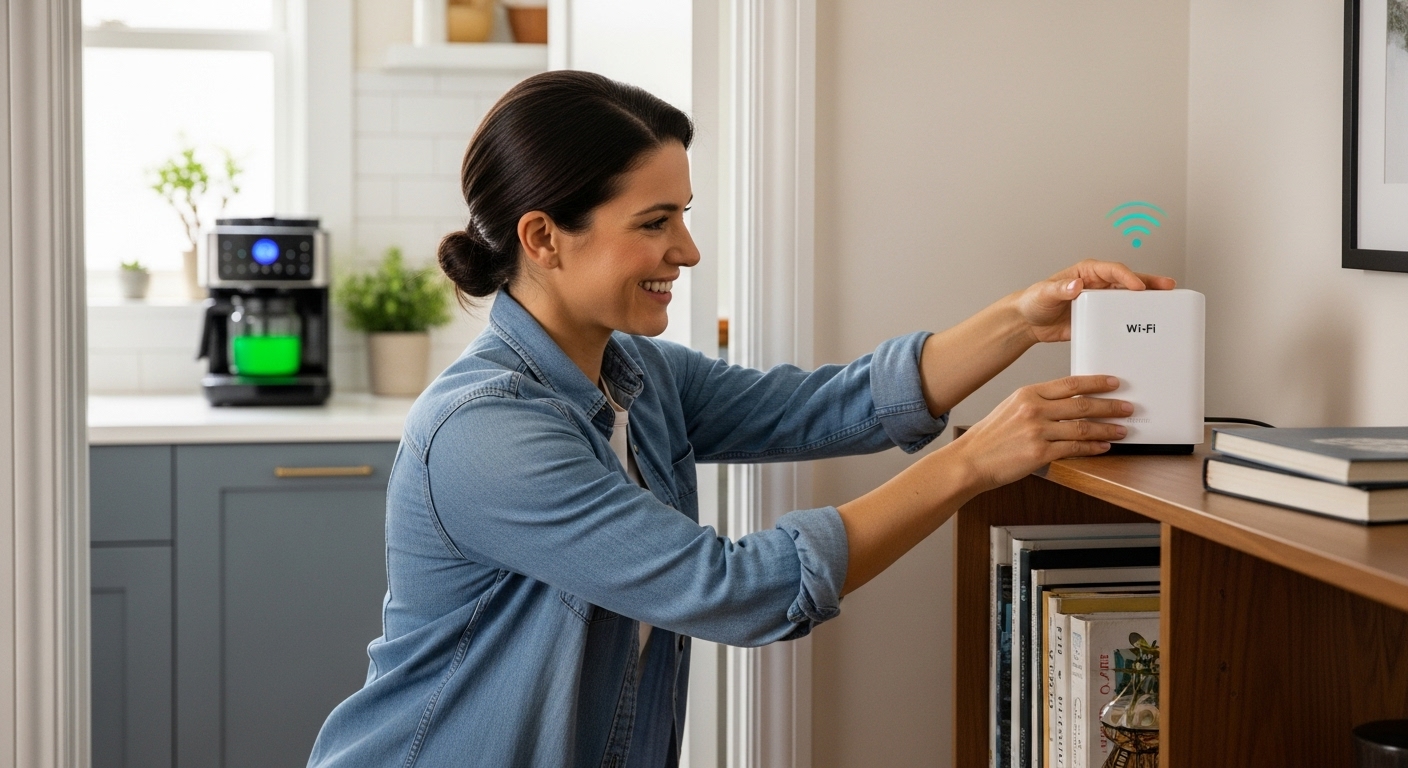Smart Home Appliance Integration: Why Your Connected Appliances Keep Disconnecting and How Vancouver Homeowners Can Fix Connectivity Issues
Struggling with smart appliances that won’t stay connected in your Vancouver home? We’ll walk you through the most common connectivity issues and practical solutions to get your high-tech kitchen running smoothly again.
Picture this: you’re rushing to prep dinner after a long day, and suddenly your smart oven won’t respond to your phone commands, your connected dishwasher is flashing error codes like it’s hosting a rave, and your Wi-Fi-enabled refrigerator seems to have gone completely rogue. If you’re nodding along thinking “been there, done that,” you’re definitely not alone in the Vancouver area. Smart appliances have revolutionized our kitchens, but when they go offline, they can feel more like expensive paperweights than the cutting-edge conveniences we signed up for.
Vancouver homeowners have been embracing smart home technology at lightning speed, and for good reason – these connected appliances promise to make our lives easier, more efficient, and frankly, pretty darn cool. But like any relationship, the honeymoon phase doesn’t last forever, and eventually, you’ll face some bumps in the road. Whether it’s your smart fridge losing its internet connection during a crucial grocery list sync or your automated coffee maker refusing to start your morning brew remotely, these hiccups can throw off your entire routine.
The reality is that smart appliances are essentially mini computers with Wi-Fi capabilities, which means they’re subject to the same connectivity challenges as any other internet-connected device in your home. From router placement issues to software glitches, network congestion to simple power fluctuations, there are numerous factors that can cause your connected kitchen to suddenly feel very disconnected. But here’s the thing – most of these problems are totally fixable with some basic troubleshooting knowledge and a little patience.
Key Outtakes:
- Network connectivity issues affect 89% of connected devices and are often fixable through systematic troubleshooting approaches
- Smart appliances typically require 2.4 GHz Wi-Fi networks and can struggle with dual-band router configurations
- Power cycling resolves approximately 70% of common smart appliance technical glitches and software conflicts
- Vancouver’s older home infrastructure and electrical systems can create unique challenges for smart appliance integration
- Professional appliance repair services specializing in smart technology can diagnose complex connectivity issues beyond basic troubleshooting

Understanding Smart Appliance Connectivity Problems in Vancouver Homes

Smart appliances rely on a complex web of connections to function properly, and when any link in that chain breaks down, your entire connected kitchen can feel like it’s gone back to the stone age. These sophisticated devices need stable Wi-Fi connections, consistent power supply, and regular software updates to maintain their smart features. Think of your connected appliances like smartphones – they’re essentially specialized computers designed for specific tasks, whether that’s keeping your food cold, cleaning your dishes, or brewing the perfect cup of coffee.
The most common culprit behind offline appliances is actually your home’s Wi-Fi network rather than the appliances themselves. Most smart appliances rely on Wi-Fi to connect to the internet or a home network, and weak or unstable Wi-Fi signals, network congestion, or router malfunctions can prevent appliances from maintaining a stable connection. Vancouver homes, especially older character houses, can present unique challenges for maintaining strong, consistent internet signals throughout the entire property.
Another major factor that affects smart appliance performance is frequency band compatibility. Most Wi-Fi routers offer 2.4 GHz and 5 GHz bands, but the majority of smart home devices only connect to the 2.4 GHz band. Many Vancouver homeowners don’t realize that their internet service provider’s basic router might not be configured correctly for smart appliances, or that they need to create separate network names for different frequency bands.
Smart home devices often communicate using protocols like Zigbee, Z-Wave, Wi-Fi, Bluetooth, and Matter. If the devices you’ve chosen use distinct communication protocols, they can’t communicate with each other, leading to compatibility issues that can make your smart refrigerator unable to sync with your home automation system. This becomes particularly problematic in Vancouver’s varied home construction styles, from heritage houses to modern condos, which create diverse electromagnetic environments that affect smart appliance performance differently across neighborhoods.
Current major appliance recalls from manufacturers like LG and Samsung affect thousands of Vancouver homes, with some posing serious safety concerns from accidentally activated controls or connectivity vulnerabilities. Consumer protection reports indicate that 89% of connected devices lack clear information about software support duration, leaving homeowners uncertain about long-term connectivity reliability.
Technical Root Causes Behind Smart Appliance Disconnections

Moving beyond surface-level connectivity issues, understanding the technical reasons why your smart appliances keep disconnecting can help you identify and resolve problems more effectively. These disconnections aren’t random – they follow predictable patterns based on how smart appliances interact with your home’s network and electrical systems.
Interference from household electronics represents one of the most overlooked causes of smart appliance connectivity problems. Interference from other devices that use the same frequency range as Wi-Fi (2.4GHz or 5GHz) can cause interference and weaken the signal, with examples including microwaves, ovens, cordless phones, and Bluetooth devices. This is especially problematic in kitchens where your smart fridge and dishwasher might be located right next to conventional appliances that create electromagnetic interference every time they operate.
Firmware and software update failures create another category of connectivity issues that many Vancouver homeowners don’t anticipate. Smart appliances run on complex software systems that need regular updates to maintain compatibility with apps, routers, and security protocols. Outdated firmware can cause connectivity drops or prevent the appliance from pairing with your smartphone, yet unlike phones or computers, many people don’t realize their appliances need regular software updates.
Router configuration and placement problems compound these challenges significantly. Incorrect placement of the router, such as in a corner or behind objects, can limit the reach of the Wi-Fi signal, particularly in Vancouver’s multi-level homes where routers are often located in basements or main floors, creating dead zones in appliance areas. Physical barriers like walls, floors, and large furniture can also block or weaken Wi-Fi signals, making consistent smart appliance performance nearly impossible.
Vancouver’s coastal climate creates an additional layer of complexity that’s rarely discussed in standard troubleshooting guides. Humidity fluctuations can affect smart appliance circuit boards and Wi-Fi modules, causing intermittent connectivity issues that seem to appear and disappear without clear patterns. This environmental factor becomes more pronounced during the region’s wet winters when indoor humidity levels fluctuate significantly.
Comprehensive Troubleshooting Guide for Vancouver Homeowners

When your smart appliances start acting up, systematic troubleshooting can resolve most connectivity problems without requiring professional intervention. The key is approaching these issues methodically, starting with the simplest solutions and progressing to more complex fixes only when necessary.
Power cycling represents the most effective first step for resolving smart appliance connectivity issues. Power cycling your smart appliances can resolve up to 70% of common technical glitches and software conflicts, making it an essential troubleshooting technique. The process involves unplugging the appliance for 1–2 minutes, then plugging it back in, which resets the internal Wi-Fi module and clears temporary software conflicts that might be preventing proper network connection.
Network configuration adjustments often provide immediate relief for connectivity problems. Create a separate 2.4 GHz SSID in your router settings to avoid confusion, then reconnect the appliance to this dedicated network. Many Vancouver internet providers offer router configuration assistance for smart home setups, which can be particularly valuable for homeowners who aren’t comfortable making these changes themselves.
Signal strength enhancement techniques become crucial in larger homes or those with challenging layouts. Position the router in a central place within your home and ensure the signal range can reach every device, considering elevating the router to a certain height for optimal coverage. Wi-Fi extenders and mesh networks particularly benefit Vancouver’s multi-story homes, providing consistent coverage across multiple levels and eliminating dead zones that leave appliances disconnected.
Vancouver homeowners should also consider the impact of neighboring Wi-Fi networks in dense residential areas, as channel congestion from nearby homes can significantly affect smart appliance performance. Network interference analysis tools can help you identify the least crowded Wi-Fi channels in your area, allowing you to manually set your router to a less congested channel for more stable connections. Additionally, professional-grade network setups that include access points specifically for smart home devices can provide a robust and interference-free environment for your connected appliances.
Frequently Asked Questions (FAQs)
How can I tell if my smart appliance is getting a strong Wi-Fi signal?
Most smart appliance apps include a feature that displays the Wi-Fi signal strength. You can also use a Wi-Fi analyzer app on your smartphone to measure the signal strength in the exact location of your appliance. A signal strength of -67 dBm or better is generally considered good.
Do I need a special router for my smart appliances?
While most modern routers are compatible with smart appliances, a router that supports Quality of Service (QoS) and allows for separate 2.4 GHz and 5 GHz networks can significantly improve performance. For larger Vancouver homes, a mesh Wi-Fi system is highly recommended for consistent coverage.
Why do my smart appliances only connect to 2.4 GHz Wi-Fi?
The 2.4 GHz frequency offers longer range and better penetration through walls and floors, making it ideal for smart home devices that don’t require high-speed data transfer. The 5 GHz band, while faster, has a shorter range and is more easily obstructed, making it less reliable for appliances located far from the router.
When to Call a Professional: Wrapping Up
If you’ve followed these troubleshooting steps and your smart appliances are still experiencing connectivity issues, it might be time to call in a professional. Expert appliance repair technicians who specialize in smart home technology have the diagnostic tools and expertise to identify complex issues that go beyond basic network configuration. In Vancouver, where older home infrastructure can create unique electrical and structural challenges, a professional assessment can save you hours of frustration and ensure your smart kitchen runs seamlessly for years to come.

